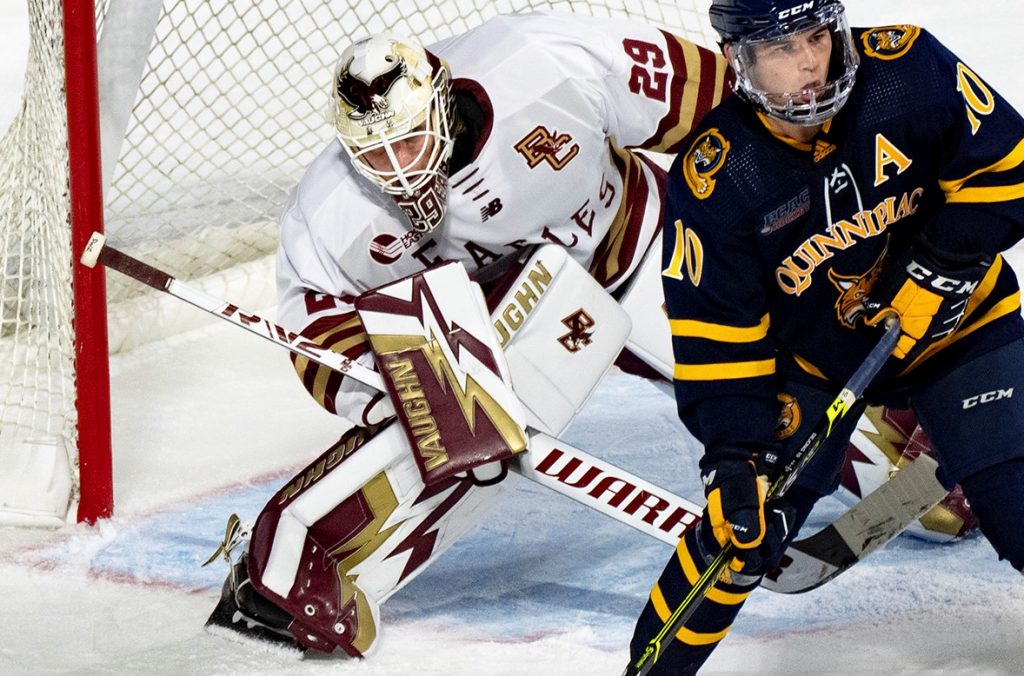
The adoption of legislation by the NCAA on April 28 that extended one-time transfers to men’s hockey may have permanently and significantly changed the landscape of the sport.
The ability for players to move to another program without having to sit a year — which only applied to men’s hockey, men’s and women’s basketball, football, and baseball before — is expected to open up a season of “free agency” each spring.
Compounding that is the extra year of eligibility granted to NCAA athletes because of COVID-19 and the suspension of programs at Robert Morris and Alabama Huntsville.
That led to an unprecedented number of players seeking greener pastures or just simply any place to play.
Grand Forks Herald college hockey reporter Brad Elliott Schlossman published an ongoing list of transfers culled from the NCAA transfer portal, which by October 1 had reached a record 154 players moving from one Division I program to another. All but 11 active D-I programs have added at least one transfer to their team this season.
While many programs have been able to fill holes or replenish rosters left incomplete by early departures, there is not a lot of love for the new transfer rules from some NCAA D-I coaches.
USCHO has discussed transfers with guests of its Spotlight and Game of the Week podcasts this season. Even coaches who have seen their programs benefit by adding transfers are not necessarily happy with the new system.
In college football, many have worried that the very best programs will be the ones who benefit the most, especially when name, image, and likeness opportunities may be a financial draw for a player.
Michigan Tech coach Joe Shawhan shared his concern that hockey will see the same situation.
“Certain schools are going to be able to say, ‘Okay, we’ll bring in these two or three first-round, second-round draft picks,'” Shawhan told USCHO. “‘But I like this player over here on this team. And I like this player over here on this team, and he knows a player on his team that played with them in juniors … I think we could have a chance at that kid.’
“Well, all of a sudden that kid’s gonna show up in the portal,” said Shawhan. “And so these teams are losing all these players to signing early and teams are going to both be able to choose to bring in the best young players they want, but they’re also going to get that experience by, in my opinion, stealing very good players from other from other teams.”
Pointing to early non-conference success against ranked teams that Atlantic Hockey teams such as Bentley and Sacred Heart have had, Providence coach Nate Leaman suggested that rather than hurting teams that are not perennial powers, that it might help.
“Originally I think Atlantic Hockey teams really worried about the the transfer thing, about losing players,” Leaman told USCHO. “But if you look at someone like Sacred Heart that has seven grad transfers, and the wins that they’re having with those older players, maybe it’s helping that league.”
In the short term, picking up graduate transfers is a way for teams with a young roster to get a bit more age and experience and for a team depleted by early departures to restock with seasoned players or to fill holes.
The need for age, experience, and maturity is even more of an issue with the presence of fifth-year players in college hockey at some level for three more seasons. At the Ice Breaker in Duluth in October, Providence lost games to then-No. 1 Minnesota State and then-No. 5 Minnesota Duluth, both programs that have built some success with older players.
Leaman noted that he had 2003 birth-year players going up against players as much as six years older and that taught the Friars that they had to be tougher.
“College hockey is old as it’s ever been,” Leaman said. “I bet you if you look at a lot of teams they’re maybe older than [AHL] teams.”
The addition of fifth-year players, either staying with their team for the extra season, or transferring to another, has also bloated rosters that would typically have 26 to 28 players.
Bentley coach Ryan Soderquist acknowledged the difficulty posed by a larger roster, both in playing time and recruiting.
“You see a lot of programs across the country — even ourselves being at 30 guys is high — it’s a lot of guys to manage and you get a lot of kids that are working really hard that haven’t had a chance to get in the lineup yet, which is tough to see,” Soderquist told USCHO. “So you know, you’re trying to manage roster size, you’re trying to manage having a little wiggle room, that really good player comes up late that you like and trying to have space and money available for that.”
D-I coaches got a preview of that future this past spring when the portal got flooded with players putting in to transfer.
The coaches who have been USCHO podcast guests all said that the players they have selected via transfer have largely been those with whom they’ve had a relationship before in some way — whether through recruiting or with players on their teams that know them from previous levels of hockey.
Yet each was concerned about a free agency season that may mirror professional sports.
“Well, I can tell you it’s not fun. I can tell you, the coaches don’t like it at all,” said Leaman. “I can tell you [that last spring] I got phone calls from my players, and [they were] just routine phone calls about, seeing a doc, or I’m gonna miss this, or going to be late. And your heart was dropping at times, because it’s that time of year, you don’t know when a kid’s gonna call you and tell you. I don’t like it.”
“[I] personally don’t like the one-time transfer,” said Soderquist. “I think it’s creating a mess in college hockey, and it’s gonna be springtime, it’s going to be free agency, and you’re dealing with that it’s kind of a pro model now, in terms of managing your team and trying to leave scholarship money open late for the transfer portal. It’s a different environment to be in.”
Soderquist noted that the portal might provide players a better opportunity to play on a team that can get them into the lineup or where they’d be a better academic fit. But that provision has always existed where there was mutual agreement between schools.
“It also on the flip side has helped some student athletes that were just in a bad situation, and they just needed a fresh start,” said Soderquist. “I’ve always believed, a kid should be able to be allowed to transfer if both institutions agree, if both staffs and both athletic directors agree, a one-time transfer should be allowed. I think that would be a good balance versus just everyone can transfer.”
Fourteen D-I players who entered the transfer portal and who did not make a D-I team, landed at D-III schools and two others at Canadian universities. But well over 100 players, mostly underclassmen, did not find a roster spot with another program.
“Two hundred fifty of them were looking for greener pastures, thinking this portal is the greatest thing in the world because they’re a depth player or not having the role that they wanted on the team they’re on and ended up not having any place to play,” said Shawhan.
“The grass isn’t always greener, for a lot of players,” said Leaman. “I think that will be seen over two or three years.”
With the one-time transfer rule now a fixture in D-I men’s hockey, coaches are going to have to adjust to the new landscape.
“I’m sure it’s here to stay,” said Soderquist. “And we’re gonna have to learn how to deal with that and have it be to our advantage.”
“If [players] are seeking glitter, they have the avenue now to leave, and we have to live with it,” Shawhan said. “I guess we have to make ourselves glitter as well.”


